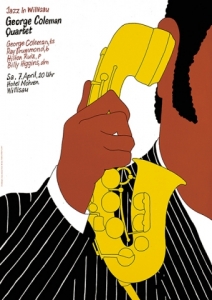All That Jazz: Niklaus Troxler at the Berlin Brohan Museum
Niklaus Troxler is one of the most renowned graphic designers in Europe. He achieved international fame with the unusual posters that he designed for over 40 years from the jazz festival he founded in Willisau, Switzerland. With “All that Jazz,” Bröhan-Musuem pursues its mission of following the strategies and structures of artistic design that began in art nouveau around 1900 and continue into the present. At the same time, the show marks the beginning of the new exhibition series “Blackbox” in the newly designed spaces on the Museum’s third floor, dedicated to poster design, graphic design and photography.
In 1966, young Swiss musician and graphic designer Niklaus Troxler held his first concert with the band The Swinghouse Six in Willisau, Switzerland, without realizing that it would develop into one of Europe’s most important jazz festivals. In around 900 concerts and 40 festivals, over 2000 musicians from all over the world have appeared in the town to date, so that the famous pianist Keith Jarrett once called Willisau “one of the best places for music in the world.” Over the course of his long career, Troxler has designed building façades, books, and corporate identities and his innovative poster designs have brought him numerous prizes and awards.
The exhibition “All that Jazz” focuses on the jazz posters that Troxler designed over the past four decades for Willisau. The posters, dedicated to the festival as a whole or to individual concerts, are among the most striking works of the now retired design professor. Troxler almost entirely avoids stylistic repetition. From the drip paintings of a Jackson Pollock to the stickmen characters of Keith Haring, from Dada to minimal, all sorts of image-making find their way into his designs. A further source of inspiration is the motif world of pop art with its comic-like representations and its references to recourse to consumer articles and advertising. “Knox”—as Troxler is known in the jazz world—designed some of his posters as ready-mades, for example, one poster as a huge envelope with the necessary concert information as address lines. In this way, Troxler uses art and visual history as an archive that he interprets and on the basis of which he improvises. His approach shows how similar graphic design and jazz music can be: it was not for nothing that Troxler was once called “the master of visualizing sound.”
Niklaus Troxler was born in Willisau in 1947. After studying design at Lucerne’s Schule für Gestaltung, he worked as an art director in Paris before founding his own graphic design studio in Paris in the early 1970s. From 1998 to 2013 he taught as a professor for communication design at Stuttgart’s Staatliche Akademie der Bildenden Künste. Over the years, his posters advanced to become popular collector’s items that are exhibited in numerous countries on four continents. Troxler’s works are included in prominent public collections such as New York’s MoMA, Stedelijk Museum in Amsterdam, Zurich’s Museum für Gestaltung, and Staatsbibliothek Berlin. He lives in Lucerne and Berlin.
The Bröhan-Museum is Berlin’s museum for art nouveau, art deco and functionalism. It is named after its founder, Karl H. Bröhan (July 6, 1921–Jan. 2, 2000), a passionate collector and connoisseur of art nouveau, art deco and the art of the Berlin Secession.
The curators of the exhibition are Tobias Hoffmann, Fabian Reifferscheidt. The exhibition started on 23 January and will close 17 July 2016.
Lily Fürstenow











